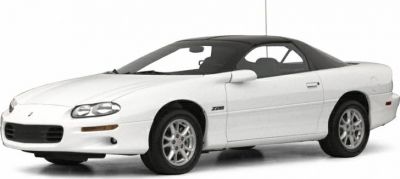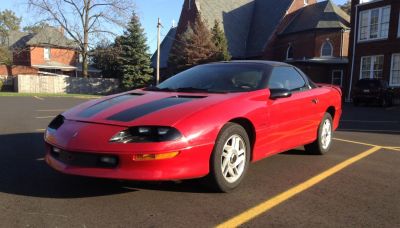 1982 Pontiac Firebird III Dimensions, Size & Specs
1982 Pontiac Firebird III Dimensions, Size & SpecsMeasurements of the 1982 Pontiac Firebird III, engineered for optimal performance and comfort
| Dimensions | |
|---|---|
| Length: | 4833 mm190.3 in15.9 ft |
| Width: | 1838 mm72.4 in6.0 ft |
| Height: | 1264 mm49.8 in4.1 ft |
The Pontiac Firebird III represents the third generation of the iconic Firebird coupe, produced from 1982 to 1992. This generation showcases a well-balanced design emphasizing sleekness and performance typical of early 1980s American sports cars. The coupe measures 4833 mm (190.2 inches) in length, offering ample road presence without excessive size. Its width reaches 1838 mm (72.3 inches), providing a stable and planted stance for enhanced handling and road grip. Standing at 1264 mm (49.7 inches) high, the Firebird III boasts a low roofline that boosts its aerodynamic profile and sporty aesthetic. This generation embodies a blend of sharp styling and practical dimensions, making it a popular choice among enthusiasts who favor classic muscle car appeal with manageable size for everyday driving. The Firebird III’s proportions ensure a comfortable yet engaging driving experience, with a compact yet roomy cabin for the coupe class. Overall, the 1982-1992 Pontiac Firebird III generation stands as a representative American sport coupe, combining distinctive looks with balanced size and performance.
Discover the standout features that make the 1982 Pontiac Firebird III a leader in its class
Have a question? Please check our knowledgebase first.
The Pontiac Firebird III, produced between 1982 and 1992, measures 4833 mm (190.3 inches) in length, 1838 mm (72.3 inches) in width, and 1264 mm (49.8 inches) in height. These dimensions give the car a sleek, aerodynamic coupe profile, typical of muscle cars from that era. The relatively low height enhances its sporty appearance, while the width offers a stable stance on the road.
With a width of 1838 mm (72.3 inches), the Pontiac Firebird III has a substantial road presence and a wide stance that contributes to improved stability and cornering ability. This width allows for a comfortable interior cabin width for passengers, while also enhancing grip and handling performance by providing a broader footprint on the road.
The Firebird III stands at a height of 1264 mm (49.8 inches), which is relatively low for a coupe. This low profile reduces aerodynamic drag, allowing for better fuel efficiency and improved high-speed stability. The sleek height also adds to the sporty aesthetics, giving the car a streamlined and aggressive look.
At 4833 mm (190.3 inches) in length, the Pontiac Firebird III is a moderately long coupe. This length provides ample space for front and rear passengers compared to smaller sports cars and offers a decent-sized trunk for luggage and daily utility. It strikes a balance between sporty dimensions and practical size for commuting or leisure driving.
The Firebird III fits comfortably into a standard single-car garage. With a length of 4833 mm (190.3 inches) and width of 1838 mm (72.3 inches), it is well within the typical garage space dimensions, which generally accommodate vehicles up to around 5500 mm (216 inches) in length and 2400 mm (95 inches) in width. Its relatively low height also ensures clearance under typical garage doors.
Compared to the Firebird II, the Firebird III made notable advancements in both size and aerodynamics. The III generation is longer and wider, contributing to improved interior space and road stability. Its lower height and sleeker design enhanced aerodynamic efficiency and gave it a more modern, sporty appeal. These changes reflect the evolution from a more angular 1970s style to a refined, performance-oriented 1980s coupe.
In comparison to contemporaries such as the Chevrolet Camaro and Ford Mustang from the 1980s, the Pontiac Firebird III holds similar dimensions. It is slightly longer than some competitors, offering more cabin and trunk space, and its width of 1838 mm (72.3 inches) also aligns with the average for muscle cars of the time. This parity in size allowed the Firebird III to compete effectively in its segment while providing distinctive styling.
While the exact weight can vary depending on engine and trim level, the Firebird III typically weighs around 1500 to 1600 kilograms (3307 to 3527 pounds). This moderate weight for a muscle coupe enables it to maintain agility and speed while offering solid road grip. Its weight plays a key role in balancing performance, fuel efficiency, and handling.
The Firebird III is designed as a two-door coupe with seating typically for four passengers. Its width of 1838 mm (72.3 inches) and length of 4833 mm (190.3 inches) provide reasonably comfortable front seats and usable rear seating, especially in comparison to smaller sports cars. However, rear space is more suitable for short trips or smaller passengers due to the coupe's sloping roofline and compact rear legroom.
Throughout its decade-long production run, the Pontiac Firebird III maintained consistent exterior dimensions, with minor variations due to facelifts and trim updates rather than structural redesigns. This consistency was typical of the era and allowed owners to expect stable handling and space characteristics. Most dimensional specifications like length, width, and height remained effectively unchanged through the generation.
Discover similar sized cars.

| Production: | 1992-2002 |
|---|---|
| Model Year: | 1993 |
| Length: | 4910-5006 mm193.3-197.1 in |
| Width: | 1893 mm74.5 in |
| Height: | 1295-1321 mm51.0-52.0 in |

| Production: | 1998-2002 |
|---|---|
| Model Year: | 1998 |
| Length: | 4907-4915 mm193.2-193.5 in |
| Width: | 1882 mm74.1 in |
| Height: | 1300-1322 mm51.2-52.0 in |

| Production: | 1992-1998 |
|---|---|
| Model Year: | 1993 |
| Length: | 4907 mm193.2 in |
| Width: | 1883 mm74.1 in |
| Height: | 1303 mm51.3 in |
